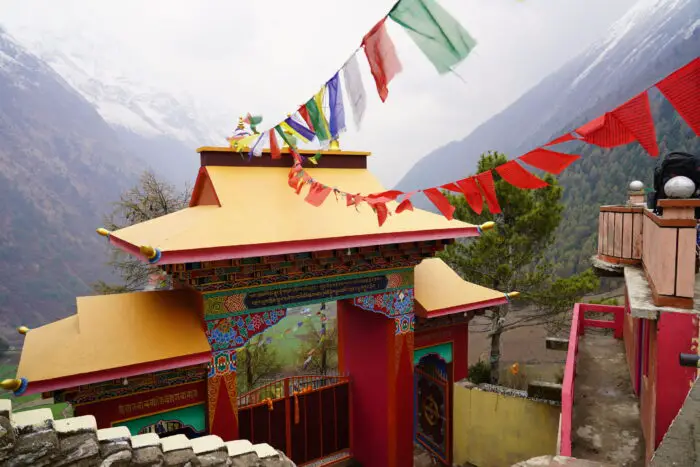The bus rumbled to a start as a man on the bus rooftop strapped the last trekking backpack to the top. It was finally time to leave dusty Kathmandu behind and start my 14-day trek around Manaslu, the 8th tallest mountain in the world.

I climbed into the bus and took a seat next to a Canadian woman who looked to be in her late 20s. She’d had some experience hiking in the Canadian wilderness, and was now on a solo sojourn through Nepal. The trek we were both about to do, the Manaslu Circuit, required a guide. Trekkers are not technically allowed to complete the hike without one.
Her guide sat behind us, eavesdropping, and attempted to swap places with me when I’d asked how she’d found her guide. Unsuccessful at switching seats, she told me that she’d met him at the airport on arrival in Kathmandu and decided to book a trek with him just a few days later.
Though I consider myself spontaneous and generally open towards strangers, I was shocked at her trustworthiness towards this stranger. Trekking through the Himalaya, no matter the route, has inherent risk. Altitude sickness, injuries, illnesses, route planning, general safety from others–you’re reliant on your guide to keep you safe. Not to mention the discomfort that often happens when you spend too much time one-on-one with someone you don’t get along with. And adding to this, someone who might have a sexual interest in you.
Leading up to my trip, I’d spent two months researching trekking guides online. After a creepy experience sailing at sea with a crazy captain with shoddy sailing skills, I was hyper-vigilant about choosing an experienced guide.
This is how I found Dawa, a trekking guide at Three Sisters Trekking who made my trek as incredible as it was. She knew which teahouses to sleep in, the best places to rest, how to ride out poor weather, where to stop for lunch, and took care of me when I caught COVID at 16,000 feet with no medical facilities in reach. Throughout our whole trip, she cared for trekkers who’d been let down by their guides, often offering advice or assistance to them as well. Many trekkers told me they wished they had her as their guide.

Though finding Dawa certainly involved a bit of luck, these were the key things I looked for when choosing a guide for my Himalaya trek.
Book your guide through a reputable company
Many trekkers look at the cost of the guide above all else. On Facebook, you’ll often have ‘guides’ soliciting their services for $15 per day. Paying this little, it’s almost sure that these guides are not equipped with health insurance or proper trekking gear, putting their health at risk. Many of the guides and porters we saw were ill-equipped and truly struggled to make it over a snow-covered pass. Booking through a reputable agency may be more expensive, like $30-40 per day, but is also likely to have systems in place to care for the guides and porters.

Guides at agencies are often career guides, not jack-of-all-trade entrepreneurs, which means they know the major trekking routes quite well and have plenty of experience guiding trekkers. ‘Reputable’ does not mean foreign-owned. I’ve seen American and British trekking companies offer trekking packages that are 3-4x the price of Nepalese packages with no distinguishing value difference. I went with Three Sisters Trekking who were very responsive for any questions leading up to the trek.
Try to meet your guide before you go
You and your guide will be heel to toe for the duration of your journey. If you don’t vibe with their personality, it could be an awkward experience. Before I went the company route, I chatted with a handful of freelance guides through Facebook. One guide became rude, calling me names, when I hadn’t replied to them in a day. Another girl I’d heard from received unsolicited flirty messages from her guide before the trek started. While it’s not always practical to meet your guide beforehand, it’s wise to hop on a video call or meet up in Kathmandu before your journey begins. If the vibe is off, you’ll still have time to back out and get a new guide.
Questions to ask:
- How long have you been guiding?
- When was the last time you led a trek along this route?
- What is your planned itinerary for this trek? Does it follow a safe acclimatization plan?
- What safety gear are you carrying? Are you trained in first aid?

Beware of your group size
Many of the international trekking tour companies will run large group treks (10+ trekkers) to popular trails like Everest Base Camp and the Annapurna Circuit. These are often even more expensive than hiring a guide with a small group of up to four trekkers. As everyone’s energy levels, health, and hiking skills are varied, you’ll be tethered to the pace and interests of your group at the end of the day. If you’re a slow trekker, you’ll be stressed about holding others back rather than going at your own leisurely pace. If you’re fast, you’ll feel hindered by those behind you. Getting a guide who can tailor the trip to you and your (small) group’s experiences will give you a more intimate experience in the mountains. Save the big group trips for a party bus ride through Europe!

